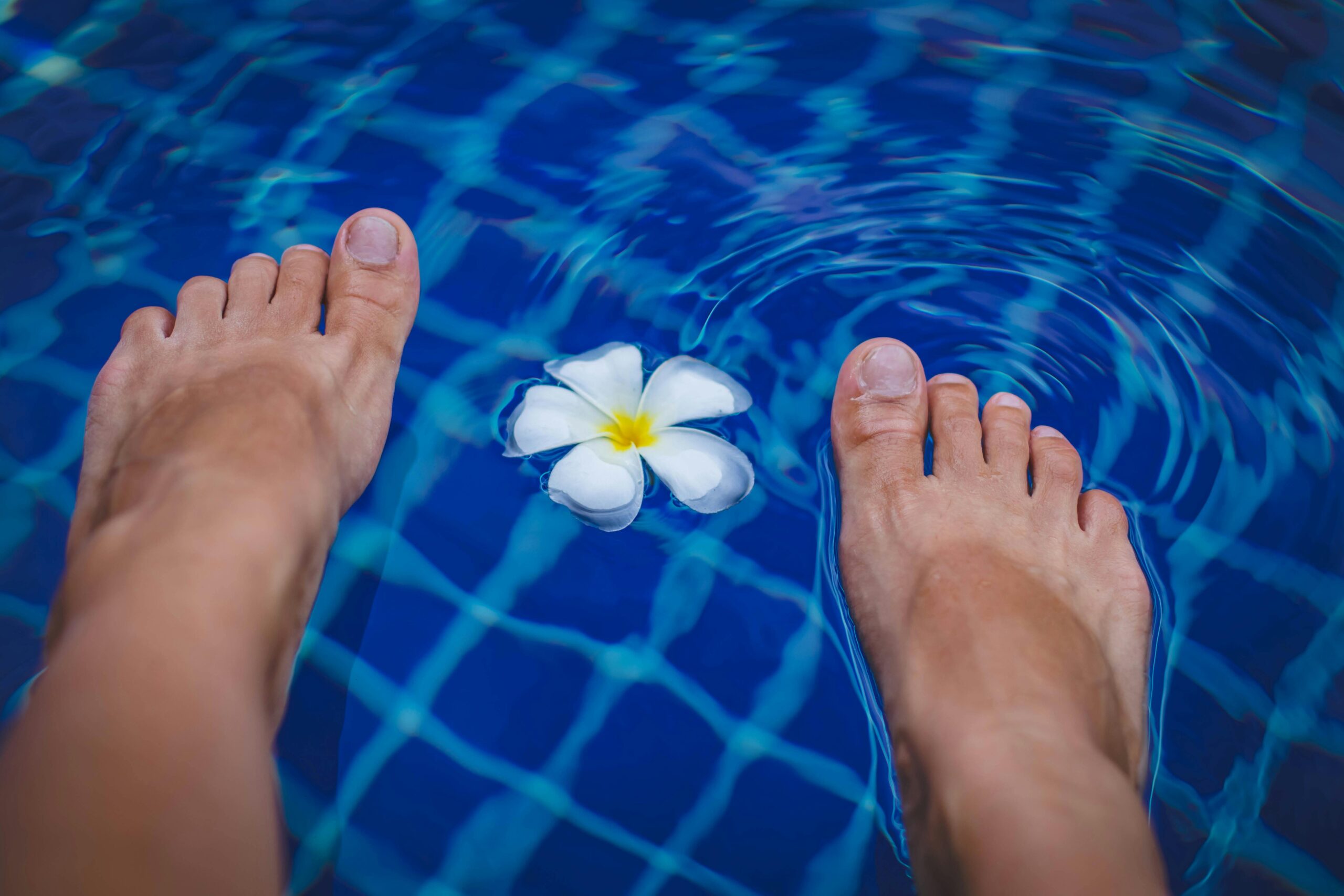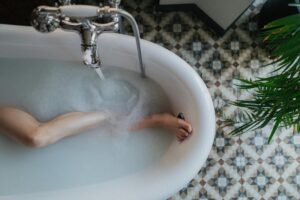Fish Pedicures Finally Explained!

Once in a while, everyone loves treating themselves to a pedicure. It’s the perfect escape from life’s everyday stressors. Who could resist sitting in a comfy massage chair and soaking their feet in warm blue water? Your stress practically melts away as the nail technician massages your calves and dumps those adorable pooka fish in the water. For those of you about to re-read my last sentence, let me save you some time. You read it correctly. I did, in fact, say pooka fish! A fish pedicure is a spa treatment that uses live fish to exfoliate your feet. Let’s dive deeper into the logistics of a fish pedicure treatment.
Fish Eating Pedicure Guide: What Is A Fish Pedicure?

Feet in water.
As we previously mentioned, getting a pedicure is extremely relaxing, partly due to the salon’s peaceful ambiance. Relaxing music and scented candles work together in creating a soothing atmosphere. The atmosphere is incredible, but it is also the reason you dread seeing the nail technician reach down and grab her exfoliation sponge. You know, the one that makes you laugh, squirm, and disturb the ambiance of the entire salon! Well, getting a fish pedicure eliminates this embarrassing situation by using a different method of exfoliation: fish!
The main purpose of a fish pedicure is to exfoliate your feet. But instead of a sponge scraping away your dead skin, there are fish nibbling it away. While it may sound painful to have fish eating dead skin off feet, there is no reason to worry. Fish pedicures are completely pain-free because they involve the Garra Rufa fish: a species with no teeth.
Fish That Eat Dead Skin Off Feet
The Garra Rufa fish, also known as the pooka fish or the doctor fish, was originally found during the 19th century in Turkey and Iran. Turks have been using the pooka fish in their spas for over 400 years as a means of exfoliation. Over time, the fish pedicure made its way to Asia, Europe, and eventually the United States in 2008.
As a member of the loach family, the Garra Rufa fish thrive in freshwater regions along the Mediterranean and the Middle East. They are versatile creatures that survive in a wide range of habitats including rivers, lakes, small ponds, and muddy streams. The Garra Rufa fish prefer water with fast currents. You will often find them swimming against, and along the direction, of the water currents. Let’s a closer look at how the Garra Rufa fish can exfoliate your feet.
Fish Eating Dead Skin Pedicure Procedure

Woman in the bath.
Salons typically store the Garra Ruda fish in a communal tank. The fish pedicure treatment begins by transferring around 100 fish from the communal tank to your foot tub. While 100 may seem like a high number, the Garra Rufa fish are tiny and work best in high quantities. Next, you remove your socks and allow a trained pedicurist to examine your feet. The employee looks for any open wounds or cuts that could lead to potential infection from the treatment.
Once you get the go-ahead from the employee, you are free to place your toes in the tub. This is where things get a little freaky! As we previously mentioned, Gara Rufa fish prefer fast water conditions. So, when your feet enter the tub, it creates a vibration in the water that emulates the fishes desired water current. This vibration prompts the fish to swim towards your feet and begin nibbling away the hard patches of dead skin. Since the Gara Rufa fish don’t have teeth, they “nibble” by sucking on your feet until the skin is pulled off. People describe it feeling ticklish and tingly, but not painful. The treatment lasts anywhere from 15 to 30 minutes, depending on the experience you paid for.
Fish pedicures are a controversial topic in the beauty industry. Before experimenting with fish pedicures, you should research the potential health risks. Let’s take a look at some possible complications of fish pedicures and how to best prepare yourself for the treatment.
Fish Pedicure Before and After
While fish pedicures help increase blood circulation, remove bacteria, and exfoliate your feet, some people are hesitant about the treatment’s hygiene and safety risks. The main issue pertains to animal waste. Fish, like all animals, make waste which collects at the bottom of the pedicure tubs. Additionally, there is no way to sanitize the actual fish between clients. As some clients seek out fish pedicures to remove foot fungus and bacteria, these infections may be transferred to the fish. Even if the tank is cleaned regularly, the fish are living creatures that cannot be sterilized. Moreover, the fish can transfer these infections to other clients when reused in the future. For these reasons, the United States has banned fish pedicures in 16 states.
It’s important to note that these risks are pretty low. However, it is necessary to be aware of potential outcomes. If you are still interested in trying fish pedicures after researching, that is totally fine! You may want to take supplements that boost your immune system prior to your appointment. This reduces your risks of infection. If everything goes well, you may follow your treatment with a traditional pedicure. After the fish pedicure treatment, your feet will literally feel smooth as a baby’s butt. Some even say it feels weirdly smooth! The most important thing to do after your treatment is to listen to your body. If anything feels strange or even a little off, talk to your doctor and make sure everything is okay.
Conclusion
Everyone loves learning about new beauty treatments, especially something unusual like fish pedicures! They are unique, exciting, and have many health benefits. However, you need to decide if it’s the right treatment for your body. While some people may love fish pedicures and swear by their results, it’s important to acknowledge that everyone’s body is different. And oftentimes, different bodies require different methods of achieving the same goals.
If you have a weakened immune system or open wounds, fish pedicures probably aren’t for you – and that’s okay! Foot pedicures are a great way of exfoliating your feet, increasing blood circulation, and removing bacteria; but they are not the only way. There are many beauty treatments that do this, some of which may work better for your body. Try ignoring “blanket statements” that say one method is better than another. The key is listening to your body and finding what works for you.

